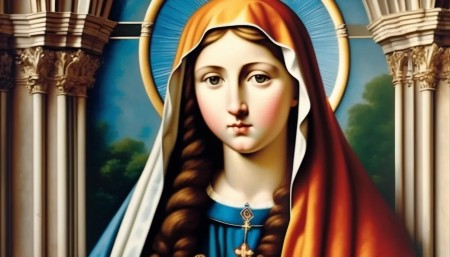 Dear readers, Catholic Online was de-platformed by Shopify for our pro-life beliefs. They shut down our Catholic Online, Catholic Online School, Prayer Candles, and Catholic Online Learning Resources—essential faith tools serving over 1.4 million students and millions of families worldwide. Our founders, now in their 70's, just gave their entire life savings to protect this mission. But fewer than 2% of readers donate. If everyone gave just $5, the cost of a coffee, we could rebuild stronger and keep Catholic education free for all. Stand with us in faith. Thank you. Help Now >
Dear readers, Catholic Online was de-platformed by Shopify for our pro-life beliefs. They shut down our Catholic Online, Catholic Online School, Prayer Candles, and Catholic Online Learning Resources—essential faith tools serving over 1.4 million students and millions of families worldwide. Our founders, now in their 70's, just gave their entire life savings to protect this mission. But fewer than 2% of readers donate. If everyone gave just $5, the cost of a coffee, we could rebuild stronger and keep Catholic education free for all. Stand with us in faith. Thank you. Help Now >
Christology and Christmas: The Catholic Church guards Christology and Christmas
Christians today often take the meaning of Christmas for granted. Unfortunately, the wonder and magnificence of the Incarnation and the subsequent birth of the humble little Christ Child, including study and reflection on these singularly unique and pivotal events in human history, are often displaced by other concerns. Often unrecognized or forgotten is the struggle, the bloodshed, and the extreme labor of the Church over the centuries to guard and transmit the truth of Jesus of Nazareth in its full purity to the entire world.
Highlights
Catholic Online (https://www.catholic.org)
12/28/2016 (7 years ago)
Published in Christmas / Advent
Keywords: Christology, God Incarnate, incarnate Son of God, Christmas, Christ Child, born in Bethlehem of the Virgin Mary
GLADE PARK, CO (Catholic Online) -- The true meaning of Christmas is centered on the historical appearance of the Christ Child in the world: that day on which the Virgin Mary gave birth (see CCC 484-507) to the incarnate Son of God, Jesus Christ, and laid him tenderly in a manger in the little village of Bethlehem about twenty centuries ago. The Lord of the universe, in and through whom all things were made (Jn 1:3), is born into human poverty as a little Child!
Each Christmas, we recall that this Child, Jesus Christ, is true God and true man, fully divine and fully human. He is a Divine and Human Child. This holy and sublime mystery of faith refers to the dual natures of Christ, divine and human, united to the one Person of the eternal Word of God--the incarnation event. It is an event of supreme importance because it is foundational to the redemption and salvation of humankind.
The Incarnation
The incarnation event: in the fullness of time the eternal Word (Logos) became flesh and dwelt among us (Jn 1:14). By the power of the Holy Spirit, the Son of God was conceived in the Virgin's womb and became incarnate, assumed an individual human nature to his divine Person, and thus became man while yet remaining fully God (see CCC 461-478). On that day long ago which we celebrate as Christmas, the God-man was born of Mary as her Son, the Anointed One (Christ) who is the God who saves (Jesus means "God saves"), the "Son of the Most High" God (Lk 1:32).
A correct understanding of the mystery of the Incarnation essential. If it is misunderstood, if its meaning is reduced and/or corrupted, the full meaning of Christmas is destroyed. That is, if God did not truly become man, taking on a full and complete human nature, identifying totally with humanity without damaging, corrupting or discarding his divine nature, then Christmas does not mean the birth of the Christ Child, the divine and human Savior of the world, but rather the birth of some other kind of child.
Additionally, there are further consequences tied to a correct theology of the incarnation event. If no incarnation event, then no redemption. If the Son of God was not incarnate and born into the world as God-made-man, the cross was not a sacrifice of the humanity of the divine Person of the eternal Word in obedience of his human will to God the Father, and therefore it would not be a saving and atoning sacrifice for humankind collectively.
The Struggle to Guard and Transmit an Authentic Christology
The Church has always worshipped the Son of God, Jesus Christ, as God himself, as one of the distinct Divine Persons of the Tripersonal Godhead. Yet teaching the same proved difficult early on. In fact, it was one of the most challenging hurdles for the nascent Church to overcome: given Jewish monotheism and the surrounding pagan nations entrenched by polytheism, how were the apostles and their associates to preach and teach that the resurrected Christ is in fact the one true God, the Lord of the universe? And how would the Church convey to the world that Jesus Christ is the Word (Logos) made flesh? Looking back first to the resurrection, then farther to the birth of Jesus of Nazareth, the Church would have to meet the challenge of extending the truth to all the world about the reality of the Incarnation and who the resurrected Jesus really is.
Early on, upholding the truth of the divine faith would come at great cost. The nascent Church suffered a great deal of persecution under Rome; the blood of many martyrs flowed for the sake of testifying to the revealed truth of Jesus Christ and maintaining fidelity to his teaching and unity with him. The first members of the Church were tortured and killed for the divine faith in horrifying ways exhibiting the utmost brutality. This time of persecution took place for roughly three centuries, from the reign of Nero (54-68) to Diocletian and Galerius (284-303). In 313 the Emperor Constantine issued the Edict of Milan, granting unrestricted freedom of worship to all Christians, and with it Roman persecution came to an end. The Church had emerged triumphant.
Nevertheless, the struggle for maintaining the purity of divinely revealed truth was far from over. Christological misunderstandings soon developed; attacks against the belief of the Church reared up, not so much with sword as with word. As some members of the Church reflected on the life of Christ and the theological meaning of his Person, questions arose and confusion soon developed. Consequently, a number of heresies sprouted and grew. Nearly all them were christological in nature; that is, they revolved around how we are to understand who Christ is in reference to his precise relation to God the Father. For example, was Jesus only a man who enjoyed God's presence and support? Was he a man who the Father adopted as his Son? On the other hand, was Jesus more divine than human? There were many questions of these types, and all of them had serious implications which had to be dealt with in order to protect the integrity of the divinely revealed doctrine of salvation in Christ. Let's first take a look at one of the most serious christological heresies in the history of the Church.
Heresy as a Threat to Correct Christology
Arianism, the most significant of the subordinationist heresies, was one of the first Christological disputes. It began with the heresiarch Arius (c. 250-336), who was a presbyter of the Baucalis district in Alexandria. The Church, of course, firmly taught that the Father and the Son were one God. Arius, however, began to question this teaching, and applied certain strands of Platonic thought to Christology. In doing so, he began to seriously de-emphasize Christ's divinity, taking the view that Jesus Christ is a semi-divine mediator between God and the world of men; perhaps a special man, but not God. Arius did not think the Son of God totally possessed the divine nature of the Father, but was merely of a like/similar nature, using the term homoiousios (of like nature/substance) to formulate his teaching. One of his methodologies consisted in using the "Father is greater than I" statement of Jesus found in John 14:28 in order to try to show that Jesus was not fully divine. He took this heretical stance far enough so as to teach that Christ was created in time and therefore ultimately a creature.
It is important to grasp how dangerous was the threat this heresy posed. Arius had attracted a number of adherents to his seriously flawed Christology. If Jesus Christ was but a creature, created in time as are other creatures, then his sacrifice on the cross could not possibly effect redemption for humankind; a mere man cannot make satisfaction to God the Father for the sins of the entire human race. Thus Arianism threatened the entire doctrine of salvation in Christ. If Arius was correct, Jesus of Nazareth was no savior or redeemer. If his false claims were not put down, the cross of Christ would become a meaningless instrument of torture as opposed to an instrument of salvation.
Although it was unusual, given that popes normally call for ecumenical councils, the Emperor Constantine requested the Council of Nicea to convene in order to deal with the turmoil caused by Arius. Although he provided an opening statement, Constantine did not preside over the Council. Pope Sylvester was the presider; although he was not physically present, he was represented by the priests Vitus and Vicentius. The pronouncements of the Council were approved by the Pope.
Some of the men present at the Council, which numbered about 300 bishops, were living martyrs who bore the marks of Roman persecution on their bodies, which they called "the stigmata." The hands of Bishop Paul of Neocaesarea, for example, were crippled from being burnt by a red-hot iron. Bishop Paphnutius of Upper Egypt suffered from crushed knees; and both Paphnutius and Bishop Potamon had lost their sight in one eye due to gouging. The latter having had his eye torn out. (Kenneth D. Whitehead, One, Holy, Catholic, And Apostolic: The Early Church Was The Catholic Church, Ignatius Press, 2000). The physical presence of these men signified the ultimate meaning of the Christian faith: willingness to surrender one's own life for Jesus of Nazareth, who is Truth Incarnate.
Arianism was condemned by the Church at the Council of Nicea in 325. There the Church, guided in part by the theological rigor and excellence of St. Athanasius of Alexandria, ruled that the Son of God, the Second Person of the Divine Trinity, is generated by the Father from all eternity, not created at some point in time as a creature. The Son, said the Council, is of the same substance (homoousios) as the Father and therefore one in being with God. The Son is perfectly God.
One-and-a-quarter centuries later, the Council of Chalcedon (451) set forth a doctrine on the dual natures of Christ which provided a basic christological definition guiding orthodox Christology from that point on. The Council stated that the divine and human natures of Christ were united at the level of his Divine Person (united in the Person of the Son of God), "without confusion or change, without division or separation." Christ, then, is not half man and half God; nor is he a strange hybrid mix of humanity and divinity. The incarnate Son did not leave behind his divinity; he did not lose his holiness; he did not cease being God when he became man. On the other hand, the incarnate Son did not absorb the man Jesus into his divinity and destroy his humanity. The incarnate Son of God, Jesus Christ, is fully God and fully man.
At Nicea an authentic Christology concerning the true and full divinity of the incarnate Son of God was defined. Jesus Christ is one in being with God the Father. The Council of Chalcedon defined how the incarnate Son of God assumed a second nature, an individual human nature, to his Divine Person and thus is true God and true man.
Although Nicea and Chalcedon continue to guide orthodox Christology to this day, misunderstanding and false teaching continue to affect large numbers of people who desire to know what is true about God, and who wish to live in accord with what God has divinely revealed. Two examples include Mormonism and Jehovah's Witnesses, neither of which believe Jesus Christ is truly and perfectly God, one in being with God the Father; nor do they accept the dogma of the Trinity, the Tripersonal Godhead. Other examples include modern day philosophers and theologians who disregard the definitive teaching of the Church and thus approve of their own individual, subjective Christology over and above that of the Spirit-guided and infallible Church which Christ himself instituted historically.
The Desire for Truth and the blessing of the Infallible Church
Truth and goodness are rooted ontologically in the human person since man is created in the image and likeness of God, who is himself Absolute and Perfect Truth and Goodness. Therefore, living in harmony with the depth of one's being entails seeking out what is true, affirming it, and fully embracing it in one's life and with one's entire self. Such is the road to happiness. And such is rooted in the meaning of Christmas.
This Christmas season, let us reflect on the sublime mystery of the Incarnation and the sacred birth of the Christ Child, true God and true man, Savior of the world. Let us also, in prayer, give thanks to the creative work of the Holy Trinity and the historical institution of holy mother Church, the dwelling place and guardian of truth, in which the true meaning of the incarnate Son of God and Christmas is preserved for all generations.
-----
Deacon Fred Bartels serves the Diocese of Pueblo, Colorado, as a member of the Catholic Clergy. He is a Catholic writer who knows his Catholic Faith is one of the greatest gifts a man could ever receive. He is a contributing writer for Catholic Online. Visit him also at joyintruth.com
---'Help Give every Student and Teacher FREE resources for a world-class Moral Catholic Education'
Copyright 2021 - Distributed by Catholic Online
Join the Movement
When you sign up below, you don't just join an email list - you're joining an entire movement for Free world class Catholic education.
-

-
Mysteries of the Rosary
-
St. Faustina Kowalska
-
Litany of the Blessed Virgin Mary
-
Saint of the Day for Wednesday, Oct 4th, 2023
-
Popular Saints
-
St. Francis of Assisi
-
Bible
-
Female / Women Saints
-
7 Morning Prayers you need to get your day started with God
-
Litany of the Blessed Virgin Mary
Daily Catholic
 Daily Readings for Wednesday, November 27, 2024
Daily Readings for Wednesday, November 27, 2024 St. James Intercisus: Saint of the Day for Wednesday, November 27, 2024
St. James Intercisus: Saint of the Day for Wednesday, November 27, 2024 Prayer to Saint Anthony of Padua: Prayer of the Day for Wednesday, November 27, 2024
Prayer to Saint Anthony of Padua: Prayer of the Day for Wednesday, November 27, 2024- Daily Readings for Tuesday, November 26, 2024
- St. John Berchmans: Saint of the Day for Tuesday, November 26, 2024
- Act of Entrustment to Mary: Prayer of the Day for Tuesday, November 26, 2024
![]()
Copyright 2024 Catholic Online. All materials contained on this site, whether written, audible or visual are the exclusive property of Catholic Online and are protected under U.S. and International copyright laws, © Copyright 2024 Catholic Online. Any unauthorized use, without prior written consent of Catholic Online is strictly forbidden and prohibited.
Catholic Online is a Project of Your Catholic Voice Foundation, a Not-for-Profit Corporation. Your Catholic Voice Foundation has been granted a recognition of tax exemption under Section 501(c)(3) of the Internal Revenue Code. Federal Tax Identification Number: 81-0596847. Your gift is tax-deductible as allowed by law.









 Daily Readings for Wednesday, November 27, 2024
Daily Readings for Wednesday, November 27, 2024 St. James Intercisus: Saint of the Day for Wednesday, November 27, 2024
St. James Intercisus: Saint of the Day for Wednesday, November 27, 2024 Prayer to Saint Anthony of Padua: Prayer of the Day for Wednesday, November 27, 2024
Prayer to Saint Anthony of Padua: Prayer of the Day for Wednesday, November 27, 2024

